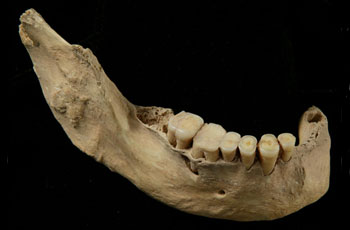Already 40,000 years ago people fed themselves to a large degree on fish.
The isotopic analysis of a bone from one of the earliest modern humans in Asia, the 40,000 year old skeleton from Tianyuan Cave in the Zhoukoudian region of China (near Beijing), by an international team of researchers from the Max Planck Institute for Evolutionary Anthropology in Leipzig, the Graduate University of Chinese Academy of Sciences and the Institute of Vertebrate Paleontology and Paleoanthropology in Beijing, the University of British Columbia in Vancouver and Washington University in Saint Louis has shown that this individual was a regular fish consumer (PNAS, 07.07.2009).

Fig.: Lower mandible of the 40 000 year old human skeleton, found in the Tianyuan Cave near Beijing. Analyses of collagen extracted from this bone prove that this individual was a regular consumer of fish. Image: Hong Shang / Chinese Academy of Sciences, Beijing
Freshwater fish are a major part of the diet of many peoples around the world, but it has been unclear when fish became a significant part of the year-round diet for early humans. Chemical analysis of the protein collagen, using ratios of the isotopes of nitrogen and sulphur in particular, can show whether such fish consumption was an occasional treat or part of the staple diet.
The isotopic analysis of the diet of one of the earliest modern humans in Asia, the 40,000 year old skeleton from Tianyuan Cave near Beijing, has shown that at least this individual was a regular fish consumer. Michael Richards of the Max Planck Institute for Evolutionary Anthropology explains "Carbon and nitrogen isotope analysis of the human and associated faunal remains indicate a diet high in animal protein, and the high nitrogen isotope values suggest the consumption of freshwater fish." To confirm this inference the researchers measured the sulphur isotope values of terrestrial and freshwater animals around the Zhoukoudian area and of the Tianyuan human.
Since fish appeared on the menu of modern humans before consistent evidence for effective fishing gear appeared, fishing at this level must have involved considerable effort. This shift to more fish in the diet likely reflects greater pressure from an expanding population at the time of modern human emergence across Eurasia. "This analysis provides the first direct evidence for the consumption of aquatic resources by early modern humans in China and has implications for early modern human subsistence and demography", says Richards.
Original work:
Yaowu Hu, Hong Shang, Haowen Tong, Olaf Nehlich, Wu Liu, Chaohong Zhao, Jincheng Yu, Changsui Wang, Erik Trinkaus, Michael P. Richards
Stable Isotope Dietary Analysis of the Tianyuan 1 Early Modern Human
PNAS. July 7, 2009. Vol. 106, No. 27
Contacts:
Sandra Jacob, Press and Public Relations, Max Planck Institute for Evolutionary Anthropology, Leipzig, Tel.: +49 341 3550-122, E-mail: jacob@eva.mpg.de
Press and Public Relations Department, Phone: +49-89-2108-1276, Fax: +49-89-2108-1207, E-mail: presse@gv.mpg.de
Source: Max Planck Society
From:http://insciences.org/article.php?article_id=6031 |
